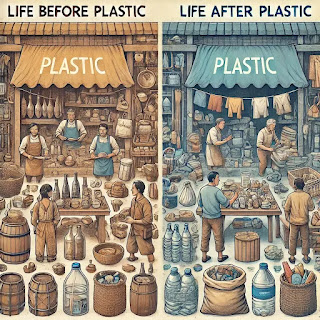Introduction
In today's world, plastic is everywhere. From the packaging on our food to the devices we use daily, it’s hard to imagine life without it. But before the 20th century, people lived in a world entirely free of plastic. How did they manage their daily lives? What materials did they use? Let's explore how people lived before the invention of plastic and what we can learn from their resourcefulness.
Natural Materials: The Building Blocks of Daily Life
Before plastic, people relied on natural materials to meet their needs. Wood, metal, glass, cloth, and ceramics were the primary materials for making everyday items. For example:
Storage and Packaging: Containers made of glass, clay, or metal were commonly used to store food and other goods. Cloth sacks and wooden barrels were used for packaging, while paper and waxed paper often wrapped food items.
Clothing: Fabrics were made from natural fibers like cotton, wool, linen, and silk. These materials were durable, repairable, and biodegradable.
Utensils and Tools: Kitchenware and tools were typically made of wood, metal, or ceramic. These materials were sturdy and could last for many years, sometimes even being passed down through generations.
Sustainable Practices: A Way of Life
Without the convenience of plastic, people practiced a form of sustainability that we now strive to achieve. Waste was minimal, and items were often repaired or repurposed rather than thrown away. Some examples include:
Reusing and Recycling: Items like glass bottles and jars were washed and reused. Clothing was mended or repurposed into quilts or rags. Metal objects were often melted down and reshaped into new tools.
Local Production: Most goods were produced locally, which meant there was less need for long-distance transportation and less packaging waste. Local markets thrived, and people were more connected to the sources of their food and products.
Biodegradable Everything: Because products were made from natural materials, they were biodegradable. This meant that even when items were discarded, they would eventually break down and return to the earth without leaving harmful residues.
The Transition to Plastic
The introduction of plastic in the 20th century brought about significant changes. It offered an affordable, lightweight, and durable alternative to natural materials, leading to its widespread adoption. However, this convenience came at a cost. The single-use culture that plastic enabled has led to significant environmental challenges that we are still grappling with today.
Conclusion
Reflecting on life before plastic reminds us that a sustainable lifestyle is possible and was once the norm. By understanding and adopting some of the practices of the past—like reusing, repairing, and choosing natural materials—we can work towards a more sustainable future. As we continue to address the environmental impacts of plastic, looking back can guide us in making more conscious choices today.



No comments:
Post a Comment